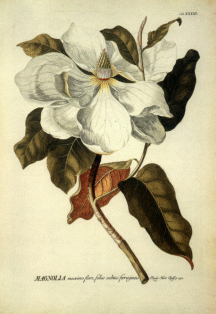May 19 - July 31, 1998
Verdant Riches Revealed: A Selection from the
Treasures of the LuEsther T. Mertz Library
at the New York Botanical Garden
Curated by the LuEsther T. Mertz Library
 A treasure trove of 80 botanical and horticultural books, from a medieval herbal to the illustrated books of French painter Pierre Joseph Redoute, were on display at the Grolier Club from May 19 to July 31, 1998. This fascinating selection from the extensive collection of The LuEsther T. Mertz Library at The New York Botanical Garden focused on herbals (12th-16th century), illustrated works of European botanical expeditions (17th-19th century), and rare horticultural treatises and garden design works (16th-19th century.
A treasure trove of 80 botanical and horticultural books, from a medieval herbal to the illustrated books of French painter Pierre Joseph Redoute, were on display at the Grolier Club from May 19 to July 31, 1998. This fascinating selection from the extensive collection of The LuEsther T. Mertz Library at The New York Botanical Garden focused on herbals (12th-16th century), illustrated works of European botanical expeditions (17th-19th century), and rare horticultural treatises and garden design works (16th-19th century.
The Western world's interest in herbal medicines did not originate in our "high-tech" age. Herbals -- books about plants with special reference to their medicinal properties -- were already on the European must-read list centuries ago. Around 980 A.D. in Salerno, Italy, scribes of the first medical school in Europe painstakingly transcribed the Circa Instans, a catalog of herbal remedies, under the guidance of physicians. A 12th-century copy of this manuscript is on display in this exhibit, the perfect counterpoint to the current wave of articles about herbal remedies in today's glossy magazines. This centuries-old manuscript, one of the earliest known copies of the medieval work, lists 258 items of materia medica written in pre-Gothic hand. It is an excellent example of the type of manuscript documentation that predated printed books and carried forward the knowledge of antiquity to the Middle Ages.
Among the herbals in the exhibition were many books printed before 1501, known as incunabula. Also included are copies of landmark works by Otto Brunfels and Leonard Fuchs from the mid-1500's, the first printed works to use illustrations drawn from the direct observation of plants in their natural setting, instead of being copied from earlier works. The herbals are illustrated with woodcuts, a relief printing surface consisting of a wooden block with a pictorial design cut with the grain. Books capturing the excitement of 17th and 18th-century global explorations feature beautiful illustrations and exciting accounts of expeditions to remote places. Of particular interest are four books published between 1775 and 1820 which document the discovery in the South Pacific Islands of the breadfruit (Autocarpus), its transport on Captain William Bligh's ship, "The Bounty," and its introduction to the West Indies.
Other books documented the introduction of the newly discovered plants of the Western Hemisphere to the gardens of Europe.The beautifully illustrated works of Pierre Joseph Redoute, the official flower painter to Empress Josephine of France, feature not only roses, but also the plants of scientific and horticultural interest introduced to the gardens of the French nobility in the 18th and 19th centuries.
The exhibition also included a selection of rare horticultural manuals and works devoted to the art of garden design. Items ranged from a 1519 edition of the first printed agricultural treatise to the first printed series of garden designs published in 1583. Selected gardening and garden design books are illustrated with early woodcuts, ambitious folio engravings, and hand-colored aquatints -- a printing method that reproduces tones similar to watercolor washes -- with moveable flaps showing before-and-after scenes.
The items in this exhibition underscored the depth and scope of the great collection of The LuEsther T. Mertz Library at The New York Botanical Garden. Assembled over the past century to support research and study in the fields of botanical science, horticulture, and garden design, The LuEsther T. Mertz Library now counts more than 1.26 million print and non-print items, and is one of the most comprehensive libraries in this field in the United States.
With this exhibition The New York Botanical Garden celebrated the generous gift of the famous collection of books about garden design and architecture assembled by Mrs. Ewing W. Reilley, a distinguished member of the Garden's Library Visiting Committee and of the Grolier Club.
A 40 page illustrated checklist accompanied the exhibition.